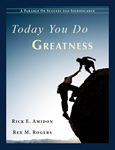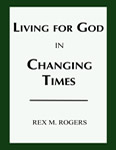- Details
- Written by Rex M. Rogers
Solomon. Just the name catches your attention. The man lived, and he lived as king during Ancient Israel's Golden Age.
Solomon was the wisest man who ever lived. During his life he spoke more than 3,000 proverbs, left us with portions of Scripture, and undoubtedly spoke and did a lot more than has been recorded for us. But what we have is significant.
Solomon wondered aloud about the meaning of life, because his general observations led him to cry, "Meaningless, meaningless. Utterly meaningless. Everything is meaningless" (Ecc. 1:2). Now had he stopped there he would have ended up like Ernest Hemingway or Kurt Cobain, who took their own lives with shotguns because life didn't seem worth living to them. But Solomon did not stop there. He systematically investigated and tried just about all the world had to offer, then he came to his conclusion.
In the last chapter of the book of Ecclesiastes, one of the most philosophical and one of my favorite books of the Bible, Solomon said, "Remember your Creator in the days of your youth...Fear God and keep his commandments, for this is the whole duty of man" (12:1,13).
Here's more from Solomon:
© Rex M. Rogers – All Rights Reserved, 2012
This blog may be reproduced in whole or in part with a full attribution statement. Contact Rex or read more commentary on current issues and events at www.rexmrogers.com or follow him at www.twitter.com/RexMRogers.
- Details
- Written by Rex M. Rogers
Arabs and Jews. Need I say more to get your attention? These people groups have been at odds since Abraham's lifetime.
But my topic is not so much the fact Arabs and Jews are often in tension if not conflict, but rather, how Christians evaluate, describe, and respond to the people of either and both lineages. I've written about this before in this blog: Must Pro-Jew Mean Anti-Arab, or Jews vs Arabs Or Jews And Arabs. But now I've written a new piece for broader distribution called "Confused Christians: Jews Versus Arabs Or Jews And Arabs."
What interests and what grieves me about this topic is how easily some Christians seem to align themselves with a way of interpreting the Scripture that ends with Christians believing the modern secular state of Israel can do not wrong. Further, people who embrace this approach argue that the United States should stand as Israel's uncritical ally. For many, though not all, who assume this position, it's an easy next step to taking an anti-Arab outlook.
For the record, I'm not against Israel per se, and I am certainly not anti-Jew. But neither am I anti-Arab or anti-Palestinian, or for that matter anti-Turk or anti-Iranian. This I can say about a people or people group even though I certainly disagree from time to time, if not often, with what given national governments do or how they position themselves, whether Israel or Arab world countries, Turkey, or Iran.
The article entitled "Confused Christians" simply recognizes that the Word of God calls upon Christian people to love all, to forgive as Christ forgave us, to share the message of the Gospel with all, to be no one's sworn enemy. This isn't la-la land thinking. I acknowledge the presence of evil in the world and the necessity of dealing with it harshlly via law and order, criminal justice systems, governments, and unfortunately at times armed forces and coercion. But these biblical principles of justice stand for all people, no matter their ethnic, racial, or national heritage or homeland.
Christians, I believe, need to pray for and work toward peace and reconciliation between Jews and Arabs even if history seems to suggest the impossibility of this outcome. God loves Jews and Arabs and salvation by faith in Christ is available to all.
© Rex M. Rogers – All Rights Reserved, 2012
*This blog may be reproduced in whole or in part with a full attribution statement. Contact Rex or read more commentary on current issues and events at www.rexmrogers.com or follow him at www.twitter.com/RexMRogers.
- Details
- Written by Rex M. Rogers
Gambling continues to plaque our society and my use of a word like "plague" gives away my perspective. Gambling is not a good thing in any way, shape, or form. It does not produce; it only takes. It does not build up; it tears down. Gambling is presented as "gaming," yet it's impact upon long-term gamblers, many who become "problem gamblers," is anything but fun and games.
Ironically, no one knows this better than serious gamblers who will tell you, as they have me, "No one wins at gambling." In fact, likely the greatest cynics about gambling are those who operate casinos in places like Las Vegas. Their comments are devastating about the people they see come and go, people who lose not only their money but often their self-respect. This is true even if the people doing the losing are "Whales," the wealthy big fish the casinos like to hook because they lose so much and lose often.
Gambling is a time bomb in a pretty package. It may tick slowly for a given person, but it does tick and it will someday go off.
All this makes it especially perplexing to hear about Christians gambling or to hear some of them defend the practice as just so much harmless entertainment. With them I must respectfully disagree. Gambling is a no-win proposition that undermines first a bank account, then social and/or professional relationships, then a life. And there is much in Scripture that speaks if not "about" gambling than certianly "to" gambling.
Here's more on the subject:
© Rex M. Rogers – All Rights Reserved, 2012
This blog may be reproduced in whole or in part with a full attribution statement. Contact Rex or read more commentary on current issues and events at www.rexmrogers.com or follow him at www.twitter.com/RexMRogers.
- Details
- Written by Rex M. Rogers
Throughout the Middle East and North Africa, and for that matter many other regions, people believe in something called the Evil Eye. It’s a superstition, but it’s real to those who believe it.
The Evil Eye is the idea that someone can look at you and, whether intentional or not and whether realized or not, cause you discomfort, injury, or bad luck. To “give someone” purposely the evil eye is the height of social ill will. The Evil Eye may also be sourced in demons or other worldly spirits that have in their power the ability to plague people with all manner of bad developments.
In the Middle East it is also possible, according to belief in the Evil Eye, to induce evil upon a person unwittingly, simply by calling attention to something good in his or her life. For example, those who believe in the Evil Eye would be horrified to hear you say they have “a lovely child” or are living in “a very attractive home.” Such compliments invite the negative attention of the Evil Eye.
Because people really do believe in the Evil Eye, charms of all shapes and sizes have been developed to ward off the potential and power of its curse. Usually such charms are made of dark blue glass or some other hard polished material on which a light blue circle is imprinted, which in turn is centered by a dark circle or dot. The design suggests an eye.
To me it’s paradoxical: wear an eye to ward off the effects of the Evil Eye. But what people believe they believe. I’ve seen these charms in shops in Cairo, Istanbul, cities in Cyprus, Beirut and other Lebanese cities. I’ve seen people wearing them on the street as necklaces, bracelets, or some other amulet. And I’ve seen them hanging from the rearview mirrors of cars.
It’s sad, actually, for the Evil Eye is nothing but a superstition, and the charms are nothing but powerless talismans. You might “give someone the evil eye,” as is said in America, but you’re giving them nothing but a glaring, frowning stare. You nor I nor anyone else holds the power of good or bad luck over anyone.
One reason we don’t hold the power of good or bad luck is that we’re finite beings. Another is that there’s no such thing as luck of any kind. Certainly Christians should believe this, though some Christians in the Middle East are susceptible to the cultural influence of the Evil Eye. But from the perspective of Christian theology you must recognize that the idea of a Sovereign God and luck are mutually exclusive concepts. Both cannot exist.
Yet people persist in believing in luck, “just in case.” Americans don’t often wear blue charms to ward off the Evil Eye, but Americans do, more often than we generally admit, embrace a host of good luck charms. Just walk through a casino and ask gamblers if they believe in luck; then ask them what’s their good luck charm. You’ll hear about rabbits feet, a special penny in a shoe, a certain piece of clothing, beads, baubles, crystals, crosses, even a given woman, and more. Professional athletes aren’t much behind gamblers in their belief in luck and lucky charms.
So while we don’t see many Evil Eye charms in America (we will), we do see our own version of lucky artifacts. Sad thing is though: it’s all a waste of time and money.
© Rex M. Rogers – All Rights Reserved, 2012
*This blog may be reproduced in whole or in part with a full attribution statement. Contact Rex or read more commentary on current issues and events at www.rexmrogers.com or follow him at www.twitter.com/RexMRogers.
- Details
- Written by Rex M. Rogers
Local communities continue to grab for the brass ring, their pot of gold at the end of a rainbow called casino gambling. Problem is, when they get there the pot of gold is either empty or being taken elsewhere. Gambling rarely if ever delivers the economic wellbeing communities expect.
Meanwhile gambling stimulates or at least makes more likely a long list of individual and social pathologies. These not-so-good spin-offs ("negative externalities," the economists call them) of gambling are rarely reported: higher rates of suicide and divorce, skyrocketing incidences of bankruptcy, job absenteeism, petty crime, and more. If these sorts of social indicators associated with gambling are not often reported, the costs incurred because of them in health care and criminal justice are even less often reported. If they were, if an accurate cost/benefit analysis could be honestly developed, it would most often demonstrate that casinos in the long run do not benefit local communities, a few constructions jobs in the beginning and a few card dealer jobs ongoing notwithstanding.
Here's more on community casinos:
© Rex M. Rogers – All Rights Reserved, 2012
This blog may be reproduced in whole or in part with a full attribution statement. Contact Rex or read more commentary on current issues and events at www.rexmrogers.com or follow him at www.twitter.com/RexMRogers.
- Details
- Written by Rex M. Rogers
A few years ago I set out to visit each of the 13 officially recognized United States presidential museums and libraries. I’ve written earlier about the first six museums I’ve visited. Now it’s time to update the list.
Lyndon Baines Johnson Library and Museum – LBJ’s museum is located on campus, University of Texas, Austin, a short walk from the Longhorns’ football stadium. The building is a “tall square,” white, and set within a large granite plaza dedicated to former First Lady, Lady Bird Johnson. Given the length of LBJ’s political career there’s a fair amount of memorabilia on display.
Like nearly all presidential museums a reproduction of the Oval Office is in the exhibit featuring original furnishings and the unique (developed for the president’s own tastes) oval rug. Unlike other museums, in this one you can sit in the office chair, which I did, and for a donation a nearby staff member will take your picture. Mine turned out pretty good.
Lady Bird was one of LBJ’s assets. First, there’s that memorable nickname. Then there’s her vision and accomplishment in beautifying America’s roadways. Finally there’s the fact she outlived him and was able to bolster LBJ’s reputation and legacy. The item in the museum I liked most was a hand-written letter from Lady Bird to LBJ expressing her confidence in his ability to lead in the wake of JFK’s assassination. It’s impressive. Mrs. Johnson’s office with a view of downtown Austin within the museum and library complex, which after LBJ’s passing she actually frequently used, is an added bonus, particularly seeing how she filed her completed work on the floor.
I did not emotionally bond with this museum, even though it reflected the times of my life. Main reason, I never emotionally bonded with the man when he was living. I didn’t share most of his politics and, like many, strongly disliked his micromanagement and misconduct of the Viet Nam War. In my estimation President Johnson and his advisors did not fight to win.
One profound issue position on which I did side with LBJ is racial reconciliation, which is to say the Civil Rights Act of 1964 and the Voting Rights Acts of 1965. The images in the museum of the Civil Rights Movement are as compelling as the Viet Nam War images are repelling.
George Bush Presidential Library and Museum – George H. W. Bush, “41” placed his large museum and library complex on the Texas A&M University campus in College Station, Texas. LBJ located his museum on the campus of the state’s most powerful university blocks from the Texas State Capitol and government district. Bush located his on the campus of the state’s premier military-related university...in the boonies.
Except for Texas A&M families, people won’t just “drop by on the way to somewhere.” They’ll have to make a special trip to see the museum. I understand Mr. Bush’s comfort zone with the military culture of the campus, but I think his museum will suffer for being where it is.
But it is a beautiful museum, features large and interesting presentations, including the story of Bush’s plane being shot down in WWII, his floating in the Pacific, and his rescue as yet a teenager, now a war hero—on film no less. The museum is large and it shares a lot about the Bush family over 3-4 generations.
Bush was known at one time as “Mr. Resume,” a cagey way of referring to his notable accomplishment of holding one key political appointment after another—Congressman, US Ambassador to UN, Republican Party National Committee Chairman, Chief Liaison of US to China, Director of CIA, Vice President, President. All of these experiences are accessible in the museum, and outside there’s a large running horses sculpture that fits south central Texas. I enjoyed the museum, just not its location.
John F. Kennedy Presidential Library and Museum – The Kennedy Museum and Library, which JFK never saw, is attractively located in Boston, Massachusetts on a point of land at the edge of the University of Massachusetts campus bordering on the bay on two sides.
Aside from the view of the water I found JFK’s museum disappointing. It’s not as dated in its look as the Eisenhower Museum, but it’s close. It needs a renovation, and more than that, it should display far more memorabilia, video, and other remembrances. For the impact former First Lady Jacqueline Kennedy made, for example, there is relatively little about her in the museum—the requisite family pics and two gowns, but that’s about it. For as stylish as she was you’d think there’d be several gowns, etc.
The best presentation dealt with the Cuban Missile Crisis of October 1962. But oddly absent, or at least I didn’t see it, is any in-depth consideration of the failed Bay of Pigs invasion of April 1961.
The events surrounding the assassination are portrayed in a short hallway on about 10-inch black and white monitors. That’s it. I understand why the Kennedy family may not want to feature that horrible day and its aftermath in November 1963. But this incredible story is summarized in a couple of TV tapes and Walter Cronkite’s announcements. Nothing more.
I didn’t bond with this president. Not much about his politics, nor his lifestyle fit, in my universe. But I was in 6th Grade when he was killed and like most Americans I can remember where I was when I heard the news—on the playground. And days later I was watching when Jack Ruby shot and killed Lee Harvey Oswald on live national television. For the significance of these events, for the incredible number of books that have been written about Camelot and its untimely end, for these events’ continuing importance, they could occupy a huge room, not a small exit hallway. These events literally changed our nation and in my estimation demand considerably more than the JFK Museum is presenting.
The George W. Bush Presidential Center is yet in development in Dallas at Southern Methodist University, former First Lady Laura Bush’s alma mater. Of course a Barack Obama Presidential Library and Museum will not be built for President Obama until he finishes his presidency.
Aside from these contemporaries, I have Hoover, FDR, and Clinton yet to go.
© Rex M. Rogers – All Rights Reserved, 2012
*This blog may be reproduced in whole or in part with a full attribution statement. Contact Rex or read more commentary on current issues and events at www.rexmrogers.com or follow him at www.twitter.com/RexMRogers.


